Geography Notes: Sustainable Development Insights
Geography and Sustainable Development Notes
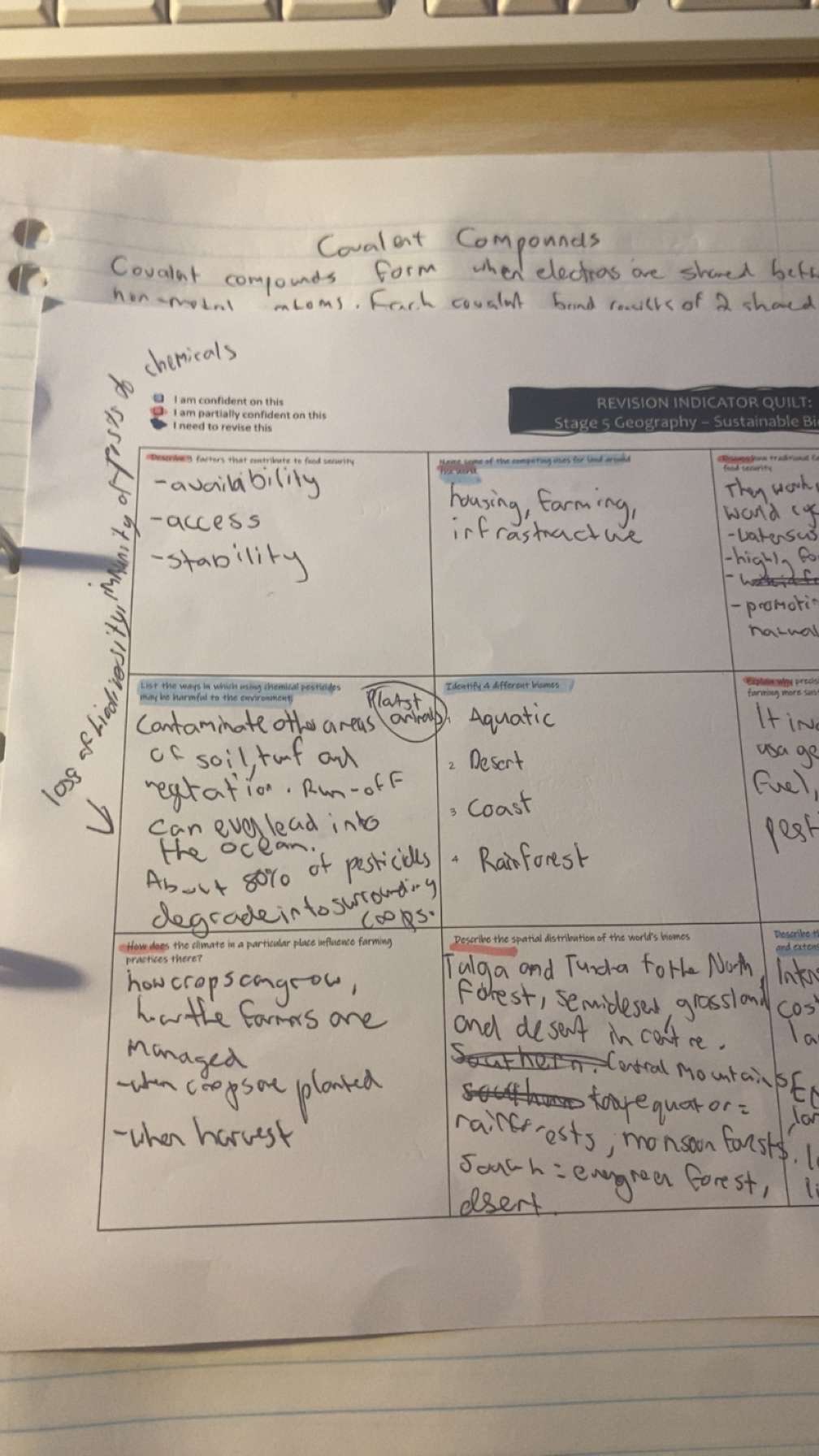
Covalent Compounds
- Definition: Covalent compounds form when electrons are shared between non-metal atoms.
- Insight: Each covalent bond results from the sharing of electrons, allowing atoms to attain stability.
Factors Contributing to Food Security
| Factors | Description |
|---|---|
| availability | Ensuring enough food is produced and available. |
| access | The ability of populations to obtain food. |
| stability | Consistency in food supply and price over time. |
- Additional Context: Food security is critical for sustainable development, encompassing physical, economic, and social access to food.
Environmental Impact of Agricultural Practices
- Contaminating Other Land: Pollutants can leach into surrounding areas.
- Run-off Issues: Excess nutrients can lead to water pollution.
- Ocean Impact: Agricultural runoff can lead to significant ocean contamination.
- Fact: Approximately 80% of pesticides degrade into surrounding crops.
Climatic Influence on Farming Practices
- Key Questions:
- How crops can grow given climate conditions?
- How are farmers managing the landed resources?
- When should crops be planted and harvested?
Identification of Biomes
| Biome Type | Description |
|---|---|
| Aquatic | Water-based ecosystems, including oceans and lakes. |
| Desert | Arid regions with limited vegetation. |
| Coast | Areas near the shore, rich in biodiversity. |
| Rainforest | Dense forests with high rainfall, important for biodiversity. |
Spatial Distribution of World’s Biomes
- Regions Noted:
- Tundra and Taiga in Northern regions.
- Semi-desert, grassland, and desert in continental zones.
- Significant ranges in southern and equatorial areas, such as:
- Rainforests: Important for carbon capture.
- Monsoon Forests: Seasonal rains influence growth patterns.
- Deciduous Forests: Trees that shed leaves seasonally.
- Deserts: Limited water resources shape ecological life.
Final Insight
Understanding these geographical and ecological concepts is vital for promoting sustainable practices and addressing global challenges like climate change and food security.
Extended readings:
lumengeo.weebly.com
SUSTAINABLE BIOMES - geography
www.worldwildlife.org
Impact of Sustainable Agriculture and Farming Practices
www.fao.org
1 Sustainability, food security and climate change: three intertwined ...
Revision Notes on Sustainable Biomes and Farming Techniques
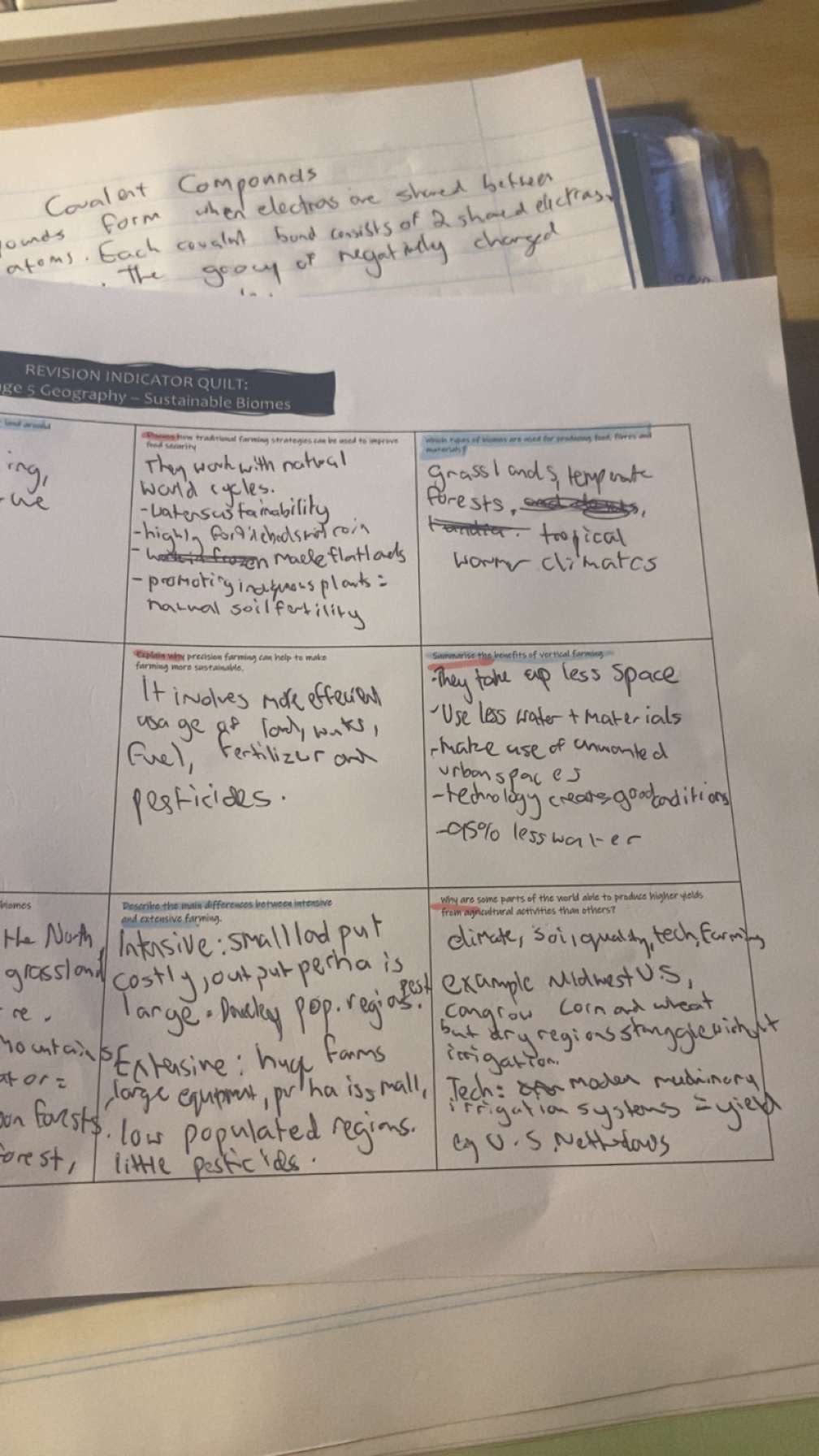
Covalent Compounds
- Definition: Covalent compounds form when electrons are shared between atoms.
- Key Points:
- Each covalent bond consists of two shared electrons.
- Atoms involved can be neutral or negatively charged.
- Insight: Understanding covalent bonds is crucial for grasping basic chemistry and how various substances interact.
Agricultural Practices
Traditional Farming Strategies
- Goals:
- Improve natural resilience of ecosystems.
- Optimize water usage and sustainability.
- Techniques:
- Utilize natural world cycles.
- Assess water transferability based on regional climate.
- Adopt high-fertility crop methods and utilize natural soil fertility.
Precision Farming
- Definition: Involves more efficient use of resources such as fuel, fertilizers, and pesticides.
- Benefits:
- Reduces waste and enhances productivity.
- Freeing up resources contributes to environmental conservation.
Vertical Farming
- Advantages:
- Requires less land area.
- Utilizes less water and materials.
- Makes efficient use of abandoned urban spaces.
- Technology facilitates controlled growing conditions, leading to higher yield.
- Consumes 95% less water compared to traditional methods.
Intensive vs. Extensive Farming
| Aspect | Intensive Farming | Extensive Farming |
|---|---|---|
| Size | Smaller plots, higher costs per hectare. | Larger areas, lower costs per hectare. |
| Equipment & Workers | Increased labor for small plots. | Fewer workers compared to land size. |
| Fertilizer Usage | Higher pesticide usage. | Lower pesticide usage, often organic. |
| Population Density | Typically in densely populated areas. | Common in rural, less populated regions. |
- Insights:
- Intensive Farming: Focuses on maximizing output per unit area, which can stress local ecosystems.
- Extensive Farming: Spread over larger areas, often relying on natural processes and fewer inputs.
Global Farming Challenges
- Factors Influencing Yields:
- Climate: Directly affects the type of crops that can be grown effectively.
- Social equality: Access to technology can dictate productivity.
- Technology: Modern machinery and irrigation systems can greatly improve yields (e.g., yield comparisons in regions like the Midwest U.S.).
- Example: Corn and wheat farming in regions with adequate irrigation, while dry areas struggle due to lack of water access.
Conclusion
Understanding sustainable biomes and farming practices is essential for advancing agricultural techniques and meeting the growing food demands of a changing global population.
Extended readings:
lumengeo.weebly.com
SUSTAINABLE BIOMES - geography
study.com
Sustainable Agriculture | Definition, Importance & Practices - Lesson
lumengeo.weebly.com
Changing Biomes - geography
Stage 5 Geography – Environmental Change Revision Notes
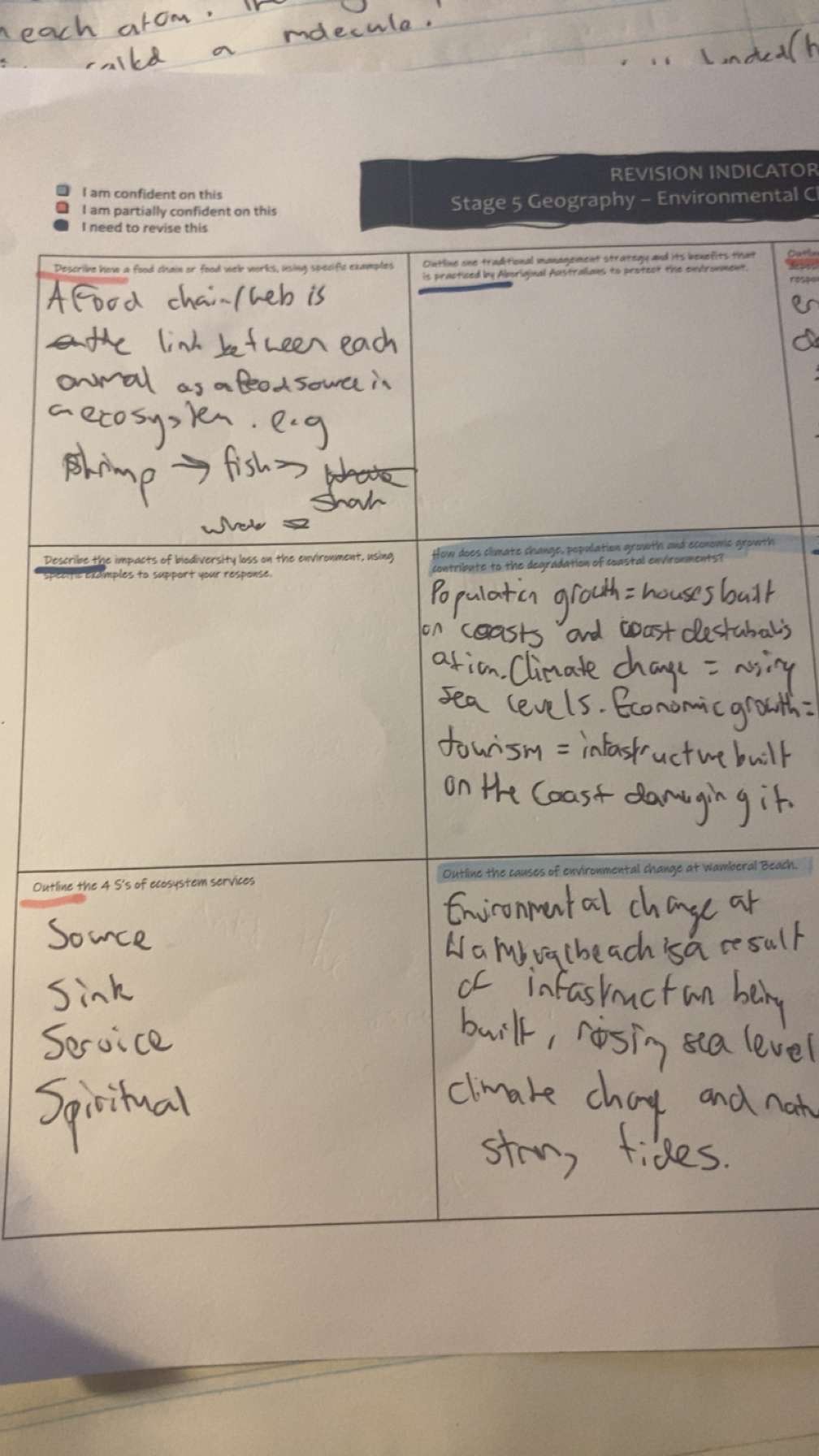
Food Chains and Food Webs
- Definition: A food chain/web illustrates the link between each animal as a food source in an ecosystem.
- Example:
- Chain: Shrimp → Fish → Shark
- Indicates how energy and nutrients flow through different trophic levels in the marine ecosystem.
Insights:
- Trophic Levels:
- Producers (e.g., plants) → Primary Consumers (e.g., herbivores) → Secondary Consumers (e.g., carnivores) → Tertiary Consumers.
- Understanding food chains is crucial for ecological balance and biodiversity.
Impacts of Biodiversity Loss
- Current Entry: No notes recorded.
Suggested Example Topics:
- Habitat destruction leading to species extinction.
- Loss of ecosystem services such as pollination and clean water.
Climate Change, Population Growth, and Economic Growth
- Key Contributing Factors to Coastal Degradation:
- Population Growth: Leads to increased housing on coastal areas, which can destabilize shorelines.
- Climate Change: Results in rising sea levels which threaten coastal habitats.
- Economic Growth: Development of tourism infrastructure along the coast can contribute to environmental damage.
Insights:
- Urbanization: As urban areas expand, they push development closer to vulnerable ecosystems.
- Ecosystem Services: The natural processes that maintain and regulate the environment are negatively impacted by human activities.
Causes of Environmental Change at Wanda Beach
- Environmental changes are influenced by:
- Infrastructure Development: Building structures near sensitive marine environments exacerbates erosion and habitat loss.
- Rising Sea Levels: A direct consequence of climate change, posing threats to coastal communities.
- Natural Events: Storms and tides can erode shorelines and impact the ecosystem.
Suggested Considerations:
- Planning for climate resilience in coastal construction.
- Preservation efforts for existing coastal ecosystems to mitigate future risks.
Ecosystem Services - The 4 S’s
| Source | Sink | Service | Spiritual |
|---|---|---|---|
| Provides resources such as food and water. | Absorbs waste and carbon, helping to regulate climate. | Offers benefits like recreation and tourism. | Represents cultural and spiritual significance of natural sites. |
Insights:
- Source: Essential for survival; includes forests, oceans, and wetlands.
- Sink: Important for maintaining ecological balance; assists in waste management.
- Service: Directly contributes to human well-being.
- Spiritual: Recognizes the intrinsic value of nature beyond economic gain; important in many cultures.
These notes provide an overview of key concepts in environmental geography related to food chains, biodiversity, and the impact of climate change while offering insights to encourage deeper understanding.
Extended readings:
nca2023.globalchange.gov
Ecosystems, Ecosystem Services, and Biodiversity
royalsocietypublishing.org
How does climate change cause extinction? - Journals
climateandsecurity.org
Sleeper Species: Increasing Threats to Great Lakes' Ecological ...
Notes on Environmental Change and Management
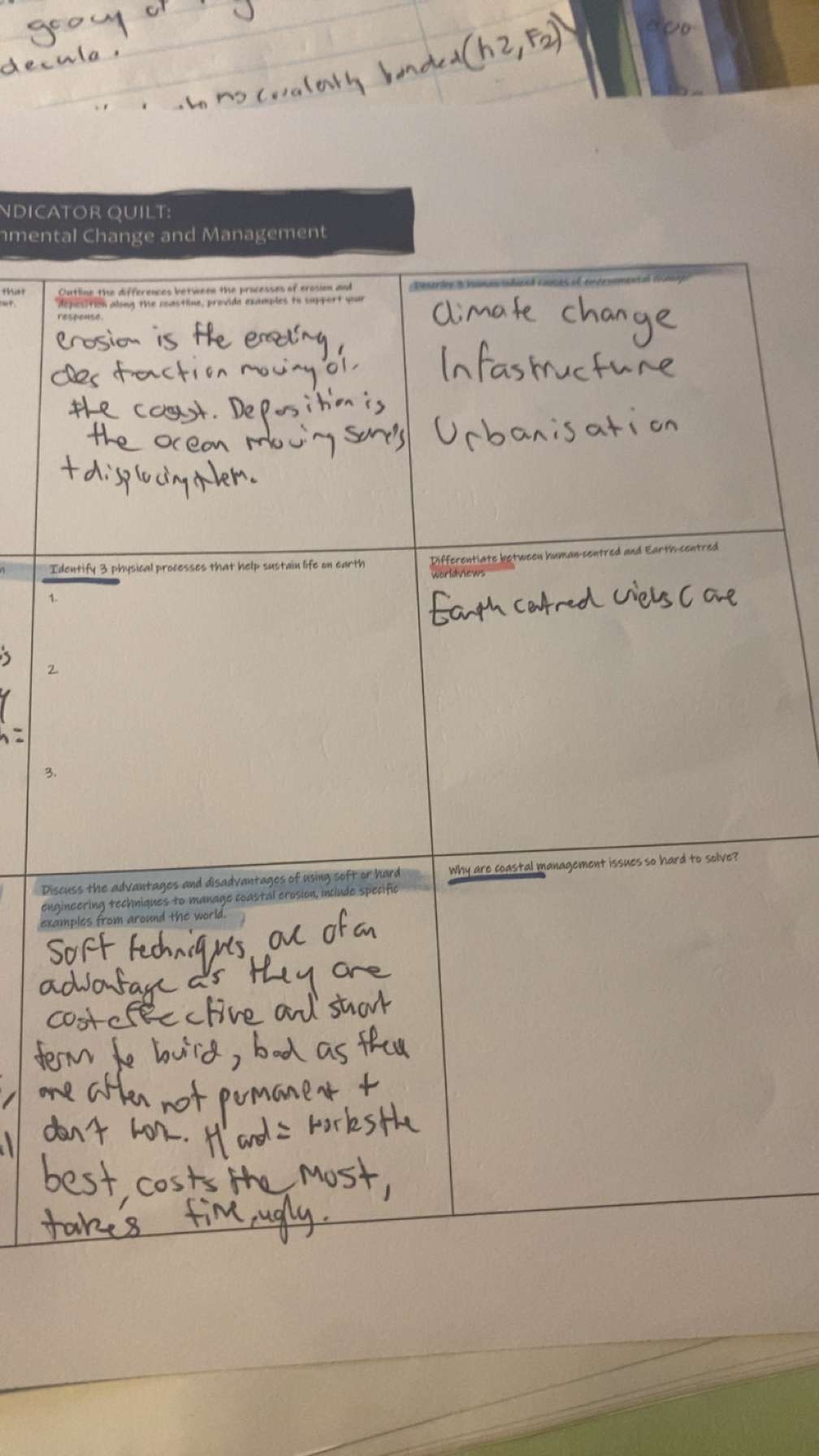
Processes of Erosion and Transportation
- Erosion: The process of rock and soil being worn away, typically through natural forces like water or wind.
- Transportation: The movement of sediments from one location to another, influenced by agents such as water flow or the wind.
Key Definitions
- Coastal Erosion: The wearing away of land and the removal of beach or dune sediments by wave action, tidal currents, or drainage.
- Deposition: The laying down of sediments transported by wind, water, or ice, contributing to the formation of new landforms.
Environmental Issues
Major Environmental Changes
- Climate Change: Refers to long-term shifts in temperatures and weather patterns, largely due to human activity.
- Infrastructure: Development in human-made structures that may impact environmental dynamics.
- Urbanisation: The increasing number of people living in urban areas, leading to changes in land use and environmental pressures.
Physical Processes Supporting Life on Earth
- Photosynthesis: The process by which green plants use sunlight to synthesize foods from carbon dioxide and water, generating oxygen as a byproduct.
- Water Cycle: The continuous movement of water within the Earth and atmosphere, crucial for sustaining life.
- Soil Formation: The process that contributes to the creation of soil, which supports plant life and agriculture.
Worldviews in Environmental Management
Human-centered vs. Earth-centered Worldviews
- Earth-centered views: Emphasize the intrinsic value of nature and the importance of ecological health in decision-making and policy.
Engineering Techniques in Coastal Management
Advantages and Disadvantages
- Soft Techniques:
- Advantages: Cost-effective, environmentally friendly, can work well in the short term.
- Disadvantages: Often not permanent and may not effectively address severe erosion.
- Hard Techniques:
- Advantages: More durable solutions, often more effective for serious erosion problems.
- Disadvantages: Higher costs, longer construction times, and can be visually unappealing.
Challenges in Coastal Management
- Coastal management issues are complex due to:
- Constantly changing environmental conditions (e.g., climate change).
- Balancing human activity and environmental sustainability.
- The need for comprehensive policies that integrate scientific research and community needs.
Extended readings:
www.tweedsandbypass.nsw.gov.au
[PDF] Coastal Environments: Change and Management
library.fiveable.me
1.8 Coastal erosion processes - Fiveable
ess.science.energy.gov
Coastal Systems - Environmental System Science Program
Geography Revision Notes
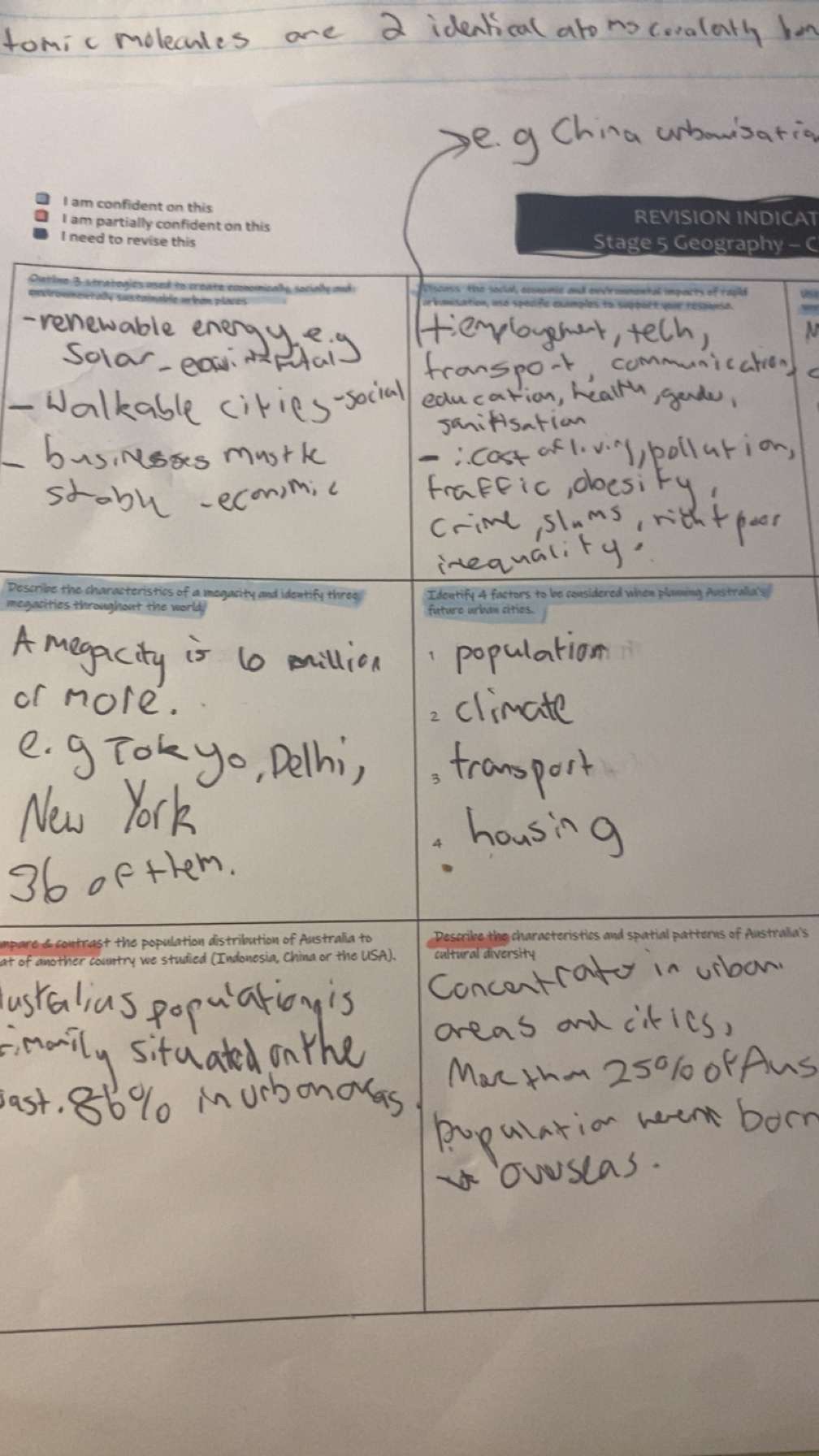
Strategies for Sustainable Urban Planning
-
Renewable Energy (e.g., Solar, Wind)
- Utilizes natural resources for energy generation, ensuring sustainability and reducing carbon footprints.
-
Walkable Cities
- Emphasizes urban design that encourages walking, promoting health, social interaction, and reducing reliance on vehicles.
-
Business Stability
- Strong and stable businesses contribute to economic sustainability in urban areas by providing jobs and services.
Characteristics and Examples of Megacities
- A megacity is defined as a city with a population of 10 million people or more.
- Examples: Tokyo, Delhi, New York
- Importance: Megacities often serve as cultural, economic, and political hubs.
Factors in Planning Future Urban Areas in Australia
-
Population
- Understanding population density and demographics is essential for infrastructure and service planning.
-
Climate
- Climate influences urban design and environmental sustainability practices.
-
Transport
- A robust transport system is crucial for connectivity within urban areas.
-
Housing
- Adequate and affordable housing options are necessary to accommodate increasing urban populations.
Comparison of Population Distribution
- Australia's Population:
- Approximately 80% of Australia’s population is concentrated in urban areas. This reflects the common urbanization pattern seen globally.
Characteristics and Patterns of Cultural Diversity in Australia
- The population shows a concentration in urban areas and cities.
- More than 25% of Australia's population was born overseas, highlighting its multicultural landscape and the importance of understanding diverse cultural perspectives in urban planning.
Extended readings:
www.mdpi.com
Sustainable Urban Transport in the Developing World - MDPI
library.fiveable.me
Urban growth and megacities | Population and Society Class Notes
www.researchgate.net
(PDF) Challenges Ahead for Sustainable Cities: An Urban Form and ...